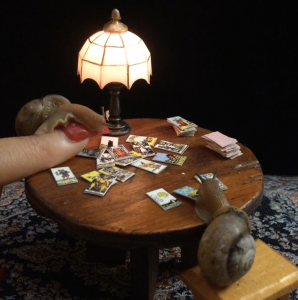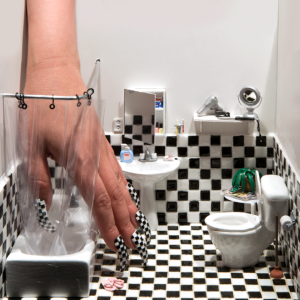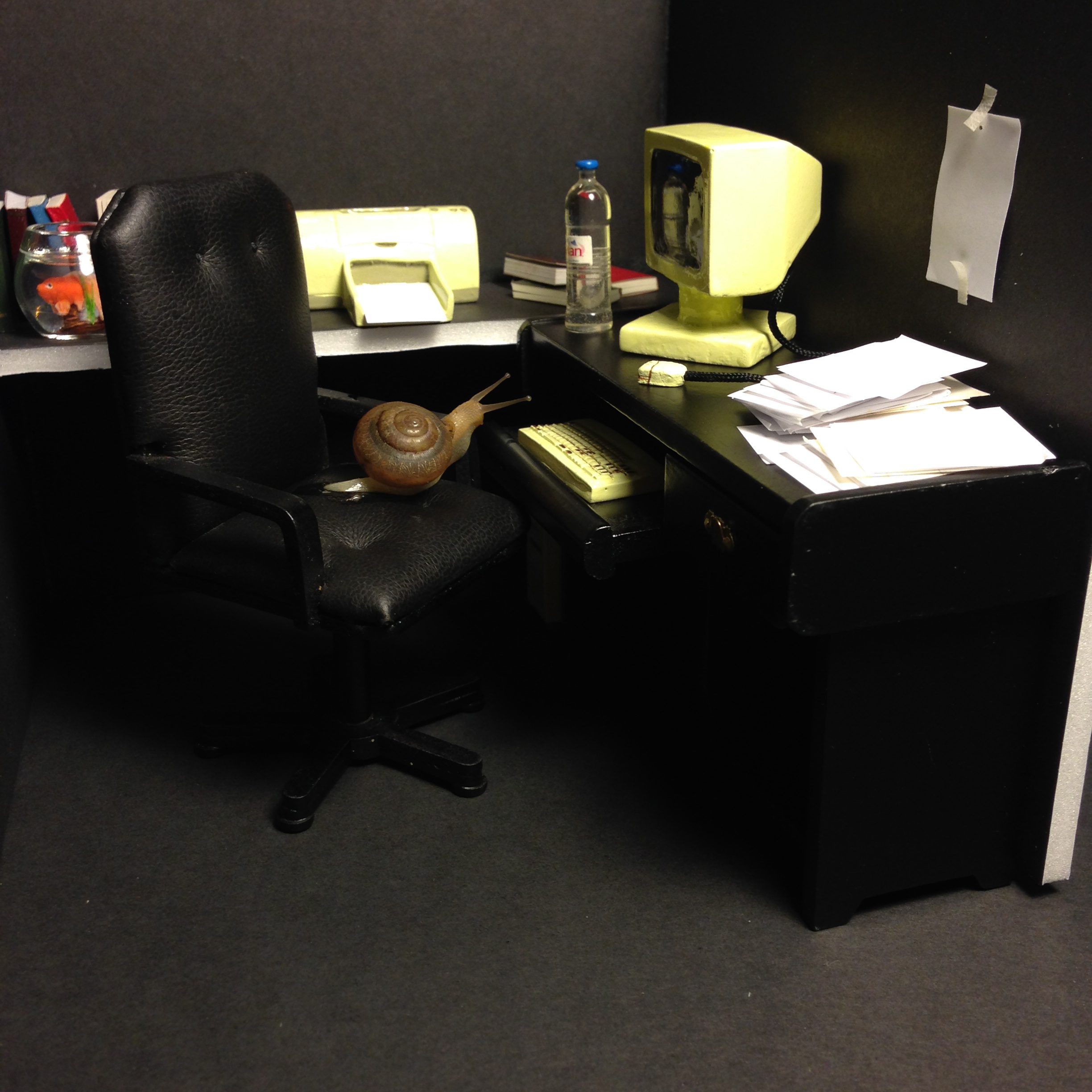Snails and Miniature Scales by Aleia Murawski and Samuel Copeland
| Instagram |
 What’s your earliest memory with miniatures?
What’s your earliest memory with miniatures?
Aleia Murawski: I think being four or five and trying to find things around my house that could be reused as beds or tables for my dolls. I remember building rooms out of an old DVD holder.
Samuel Copeland: My grandpa and uncle were avid modelers as well as my dad. They built mostly military models; airplanes and tanks. The one model that sticks out in my memory was a sailing ship called Lydia that my Grandpa built from scratch. I spent many hours playing with that model and peering through the windows to examine the detailed captain’s quarters.
Tell us a bit about your collaboration together.
AM: We work together at a photo/design studio with two other artists. We are all collaborating and creating things together all the time. Sam and I were making molds of my hands and fingers for awhile… I can’t remember the first project. We’ve made so many weird things in the last two years!
Aleia and Sam’s newest video “worms” debuted at The Museum of Modern Art on March 18, 2017 as part of PopRally Presents Petra Collins: In Search of Us:
Can you recall the first miniature scene you worked on together?
SC: We made a 1/12th scale miniature bathroom using polymer clay and found objects. We shot still images of it incorporating Aleia’s hand for scale.
AM: This was before we found the snails… We were walking back from work one day and we both were talking about how we used to make miniature rooms—as kids or in college—and I think we were like, “Oh my god, we need to do something together.” I was really interested in nail art. We made this tiny bathroom that matched these long black and white press on nails.
Can you share a bit of background on how your snail characters play a role in all of this? 
SC: We started incorporating insects and small living creatures into miniature environments to experiment with scale and moving image. I went home last summer and found three snails in my mom’s garden. We made a terrarium for them. I initially got them not knowing much about them. Within the first week, we learned so much about snails. Snails are mollusks. Any snail can mate with any other snail and they both lay eggs. We quickly learned how quickly snails could reproduce. This spring we had 70 baby snails that were smaller than a grain of rice. We had to release a bunch of snails back into nature, but we still a have about a dozen. Also, they can live between 5-7 years.
AM: We can identify our first 3 snails because they are the biggest. One snail, Noodle, has a chip on their shell when we found them. We consider Noodle to be our main actor/actress. He/she is the most animated on set. We are really interested in how bugs and live creatures occupy miniature spaces, how they interact with different objects, and how they challenge the viewer’s perception of scale.
What’s a day in the studio like?
SC: We are always actively collecting and building miniatures. Often we’ll find or make one specific object that will be the influence for creating a certain scene.
AM: Our process is spontaneous and ideas will come quickly. We will work off objects from our collections. A recent project was inspired by a friend of mine who is a Tarot reader. We knew we wanted the snails to interact with Tarot cards. In this case, we made the cards and the rest of the environment was arranged from our shared collection of minis.
Any tips for miniature enthusiasts looking to grow their collection?
AM: This year, we discovered mini conventions. They are such a good place for inspiration and finding new pieces for your collection—and for meeting other miniature makers!
What’s your favorite type of scene to create?
AM: I am really interested in creating scenes that are familiar and sweet but also a little sad. But in a funny way. Having a snail working in a really cramped office space or moving out of a morning-lit apartment room all alone or decompressing on a cucumber in a fancy bathroom… Scenes that are about daily life and stress, but are meant to be something we can laugh at a little.
SC: A couple years ago I bought a wallpaper mural for bedroom wall. It is a large photograph of a forest during fall. Since then, I have started to incorporate landscape photographs into my miniature rooms. I like to find old landscape photos from books and posters and I’ll essentially use them as wallpaper in my miniature rooms. I find a lot of enjoyment in the interplay between the two dimensional photograph and the three dimensional objects.
What’s the most challenging aspect of your work with miniatures?
SC: Practicing and working towards an ability to capture and replicate details in the most efficient way possible. I’m constantly looking at the objects around me in my everyday life and trying to imagine how they can be incorporated and transformed into miniature objects.
AM: Figuring the best way to place the viewer into the miniature environment and convey scale that is both believable but also a little surprising too.
Tool, technique, or material you can’t live without?
SC: My dad is a potter so I grew up sculpting with clay. It is often my fallback when trying to make something in miniature.
What advice would you give to new artists? What do you wish someone had told you when you first got started?
SC: Stay busy and always be making something, even if it is crude or quickly made. It just feeds into the process and will inform larger projects and refine your skill set.
AM: Yes, that’s huge. I can lose confidence really easily in my work. So, surrounding myself with positive and creative people has been motivating, as well as having a really consistent practice. Working on things often… setting up a schedule for yourself so that you stay on it.
Check out this video of a snail in a dining room!
Favorite miniature you own by another artist?
AM: We met Mary Ann and Grover Ledyard at a miniature convention this summer. Their company Wright Guide Miniatures is based out of Michigan. They are a couple that create and sell miniature rooms as well as pieces that make up the rooms. We were drawn to the variety of minis they make: from the cutest ice cream cones to a dirty mechanic’s garage. We both picked up some new favorite minis. Mine is a tiny spilled Pepsi cup with little ice cubes scattered and Sam got all of these scientific specimen jars.
What is the most memorable miniature or mini scene you have ever seen by another artist?
SC: I have always been a huge fan of Ray Harryhausen and his use of miniatures in stop motion animation. I have always loved watching the Clash of the Titans, Jason and the Argonauts and the Sinbad movies. They are all super inspiring.
AM: This show I saw in Chicago by this artist Chris Bradley. He made these miniature ceilings of different rooms, suspended from the ceiling of the gallery. I walked through it trying to place myself in all these different locations: a convenient store, an outdoor sporting goods, a club… I love that these little subtle elements could dictate an entire space. I have started gazing off at ceilings in grocery stores or wherever now and I think about the show. I think that’s the power of minis: they often imitate our own environment but in turn make us see our surroundings in a new or different way.
What would you like to see replicated in miniature that you have not yet seen?
AM: A heart-shaped hot tub.
Favorite miniaturists?
AM: I just got a piece from Christina Kenton who is based in Vancouver. She makes these incredible lighter sculptures. I am really inspired by her work, as well as mini maker and collector Ambar Navarro based in LA. I love how she incorporates minis into still lifes and video sets.
What’s to come from Aleia Murawski and Samuel Copeland?
AM: The next thing I want to make with Sam is a miniature funeral home. Also, there will be a snail proposal too.
SC: This year, I have been working on a miniature art gallery with the intent of having friends and fellow artist create miniature works to be shown in the gallery. It is a bit of a longterm project, but I’m hoping to have the gallery finished up sometime in the next month or two.
Anything else you would like to add?
AM: I’m actually scared of bugs. Snails are a very big exception. They are very dog-like.
Aleia Murawski and Samuel Copeland are both based in Chicago, Illinois. To see more of their collaborations, head on over to Instagram.
